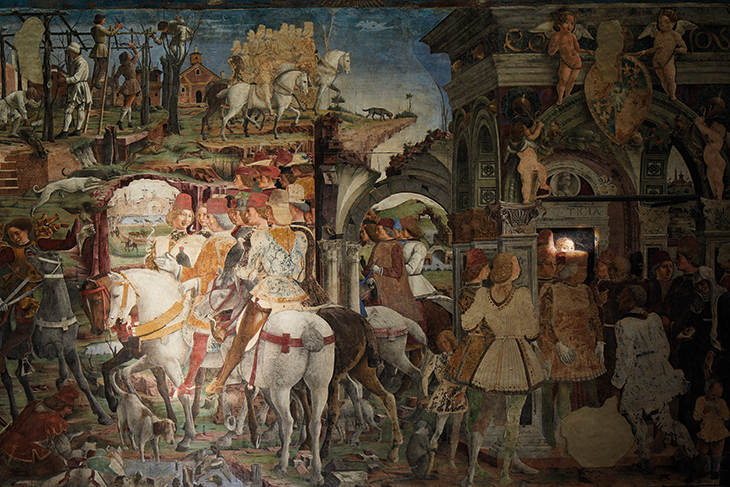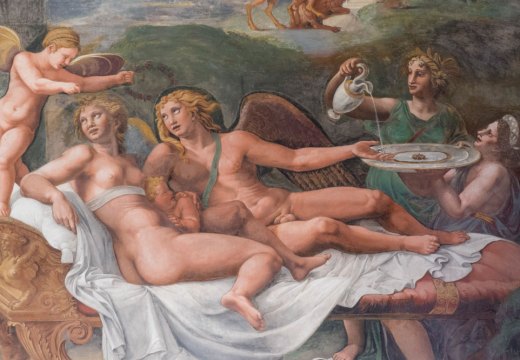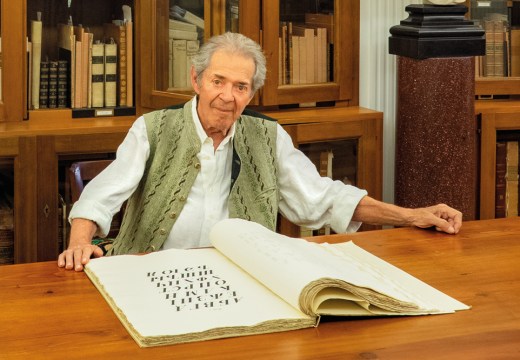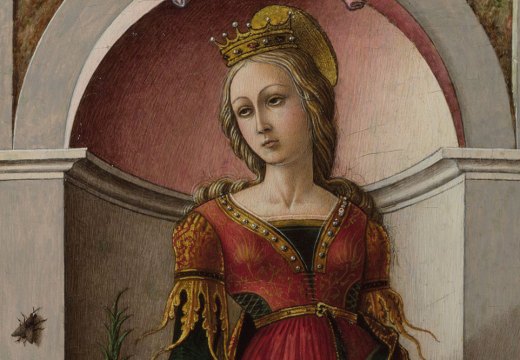Ferrara is a world unto itself. At dusk on a hot evening in July, the medieval ramparts reverberate with cicada song so exuberant that it feels as though a belt of sound is girding the city. The walls enclose a network of streets, vistas, public spaces and gardens that was planned from the 14th to 16th centuries; it is so well preserved that, strolling down the empty Corso Ercole d’Este (‘the most beautiful street in Europe’, says the manager of the hotel I’m staying in), I half expect one of the Estes of old to step through the studded facade of Palazzo dei Diamanti for their evening passeggiata.
Even the bread here is distinctive – and redolent, at least anecdotally, of a time when Ferrara was one of the leading cultural centres of the geopolitical jigsaw of early modern Italy. The coppia ferrarese combines two twists of dough, baked into a cross shape that looks a bit like the narrowed ‘X’ of a chromosome. Its appearance, explains Giovanni Sassu, curator of the Museo della Cattedrale and the Musei Civici di Arte Antica, has often been associated with the scroll held by the Christ Child in the Madonna of the Pomegranate, commissioned from the young Jacopo della Quercia for the cathedral in 1403; the sculpture is sometimes known as the Madonna del Pane.
We have been breaking that bread in the garden of Palazzo Schifanoia, where a small open-air cafe amid trees and flowers makes for a homely spin on the delizia, or pleasure palace, as which the building itself was erected by Alberto V d’Este in the late 14th century. This was a residence on the south-eastern fringe of the city, designed for the ruler of Ferrara to schivare la noia, to dodge boredom, through rest, study, and the courtly diversions of hunting, jousting and the like. By 1470, Palazzo Schifanoia had reached the height of its splendour, revamped by Borso d’Este (1413–71), who extended the building in the late 1460s and reoriented it around a great hall, the Salone dei Mesi, for which he commissioned an elaborate cycle of mural paintings in fresco and tempera to celebrate his rule. Perhaps in anticipation of Borso’s investiture as Duke of Ferrara in 1471, these works were turned around quickly, probably in less than a year, by a platoon of Ferrarese artists (at the contemporaneous Camera degli Sposi in Mantua, with which they are often compared, Mantegna spent nearly ten years on his great paean to the Gonzaga dynasty). The paintings would be plastered over in the first half of the 18th century – long after the Estes had cut and run for nearby Modena – only to be rediscovered around a hundred years later. Their enigmas have puzzled art historians ever since.
Since the turn of the 20th century, Palazzo Schifanoia has been the seat of the city’s civic art gallery. For the last two years, however, the museum has been closed, undergoing structural reinforcements deemed necessary in the wake of the two powerful earthquakes that struck Emilia-Romagna in 2012, killing 27 people and damaging many buildings in the region. While the closure was unavoidable, it has allowed for innovation, not least with the installation of a new lighting system in the Salone dei Mesi designed by Studio Pasetti, with technology supplied by iGuzzini. When Palazzo Schifanoia reopened to the public on 2 June, its grand designs were illuminated with a clarity and coherence that has long been wanting.
The monumental staircase that once led to this room from the garden is long gone. Entering from it, Borso’s guests would first have seen an image of their host, perhaps receiving the title of Duke of Modena and Reggio from Emperor Frederick III in 1452 (only fragments survive). All the same, to pass through a later doorway in the west wall is to encounter what, for all its losses, remains one of the most commanding set pieces of the quattrocento. Directly opposite is the celebrated east wall, frescoed by Francesco del Cossa (c. 1436–78) and to the left the north wall, covered along its 25-metre length with frescoes by various hands. The lighting designer, Alberto Pasetti Bombardella, has just begun to talk me through the newly installed floor-level LED system when a crash causes us turn around: another visitor has tumbled backwards over a bench while trying to take it all in, Stendhal syndrome retuned to slapstick.

March on the east wall of the Salone dei Mesi in the Palazzo Schifanoia, Ferrara (with details accented). Photo: Henrik Blomqvist
As executed, the paintings of the Salone dei Mesi would have presented an all-encompassing vision of Borso’s valour and virtues. The walls were divided up into sections representing the months, interspersed with cityscapes that have for the most part crumbled (these scenes were applied a secco, a less durable technique than fresco). The months were split vertically into three registers: at eye-level, a glorified chronicle of courtly activity with multiple depictions of Borso in each scene, perennially magnificent and magnanimous; above this, a band depicting the signs of the zodiac and personifications of the fixed stars against a background of deep blue; and in the upper register, a pageant of the Olympian gods, drawn by mythical and heraldic beasts on chariots. With their stylised pleats, some of these look like carnival floats that have been kitted out as giant slabs of Viennetta.
The illusion must have been that of a vast loggia hung with tapestries (which Borso collected), giving way to views of a peaceful city beyond. But unlike tapestries, which are so often all surface, many of these scenes bring together a sophisticated flatness, perhaps learnt from miniature paintings, with local explorations of volume and depth. In the lower register for April (by Cossa), for instance, a frieze of the Ferrarese Palio, with its diminutive figures careering across the picture plane, appears above an open archway that gives on to a sweeping landscape; in front of that archway sits a pageboy, his feet dangling over the cornice painted below the scene. He belongs to both the charmed world of the painting and to the space in which Borso’s guests and attendants were invited to view it, as if to insist that they are one and the same.
There have been, and still are, many mysteries here – of conception, of attribution, of what has been lost. To earlier scholars, the figures of the zodiac register were perplexing. Their puzzle would be solved by Aby Warburg in a lecture of 1912, when he deciphered them as ‘survivals of astral images of the Greek pantheon’, which had migrated to India and returned to Europe via Persian astrology, to be introduced here by the humanist scholar Pellegrino Prisciani. The authorship of many of the scenes is unresolved, as is the question of how many artists were involved. The angular idiom of the September section is usually ascribed to a young Ercole de’ Roberti, for example, but whether the adjacent section representing August is by his master remains a matter of some conjecture (a short train ride away, in Bologna, the subsequent chapter of de’ Roberti and Cossa’s careers is explored in an exquisite exhibition at Palazzo Fava that reunites the surviving panels from their Griffoni Polyptch; until 10 January 2021). The extent to which the painters were overseen by some kind of artistic director also remains open to debate; many art historians have sought, with no conclusive evidence, to fasten the court painter Cosmè Tura to the role.
For Pasetti Bombardella, lighting the paintings has been a way of thinking beyond their inscrutability – or rather, of turning away from scholarly cul-de-sacs and working with what it means, as a visitor, to encounter this remote cosmology with its busy detail and many lacunae. While the new system, at its staple setting, casts an even light across the walls at a colour temperature that has been carefully matched to their palette, at hourly intervals it switches to a more fanciful mode: its ‘profilers’ pick out first the zodiac register, as if to replenish its mysteries, then dozens of smaller details, which have been selected by Sassu and are delineated with the help of gobo templates attached to the luminaires. It is a neat and unobtrusive way of beckoning to the imagination – of reminding us that, for all its erudite order, the Salone dei Mesi is a space of evocation, of a world no more than partially knowable, which teems with idiosyncrasies and surprises.
From the September 2020 issue of Apollo. Preview and subscribe here.
Unlimited access from just $16 every 3 months
Subscribe to get unlimited and exclusive access to the top art stories, interviews and exhibition reviews.














![Masterpiece [Re]discovery 2022. Photo: Ben Fisher Photography, courtesy of Masterpiece London](http://www.apollo-magazine.com/wp-content/uploads/2022/07/MPL2022_4263.jpg)
Why are fathers so absent from art history?